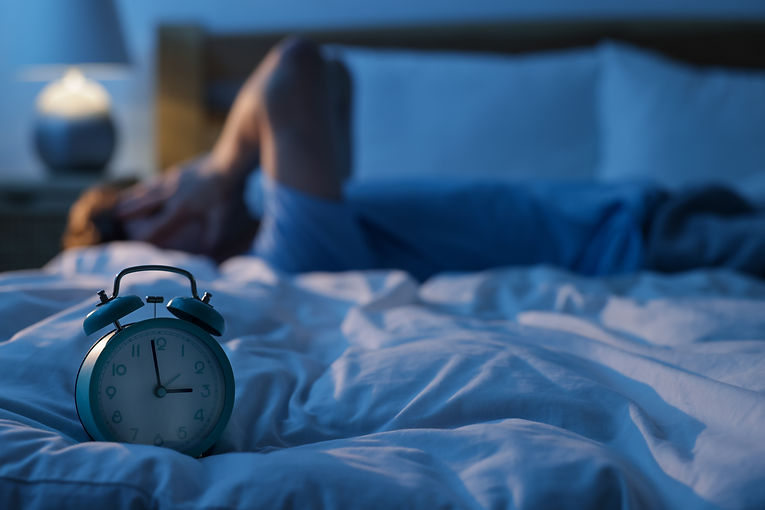
CBT-I and Chronic Insomnia
A Structured Approach to Improving Sleep
What Is Insomnia?
Insomnia is a sleep disorder characterized by the persistent difficulty in falling asleep, staying asleep, or waking up too early, despite feeling sleepy and having the opportunity to sleep. People with insomnia may lie awake in bed, unable to sleep, even though their body is tired and their environment is conducive to rest. Chronic insomnia refers to these difficulties occurring at least three times per week for three months or more, often leading to daytime fatigue, impaired concentration, and reduced quality of life.
What Is CBT-I?
Cognitive Behavioural Therapy for Insomnia (CBT-I) is a structured, short-term treatment designed to address the thoughts, behaviours, and environmental factors that contribute to and maintain chronic insomnia. CBT-I is not a quick fix; rather, it's a learning process that helps you develop and apply strategies to establish healthy, sustainable sleep patterns.
Core Principle: Sleep cannot be forced; it must be allowed. The aim of CBT-I is to create optimal conditions for sleep to occur naturally, instead of trying to actively "make" yourself sleep.

CBT-I Components: How We’ll Work Together
CBT-I integrates several key techniques, which will be tailored to your individual needs:
1. Cognitive Restructuring
Understanding Thought Patterns: Many individuals with insomnia develop unhelpful thoughts such as excessive worry about sleep ("What if I don’t sleep tonight?"), replaying daily events, planning for tomorrow, or evaluating past sleep performance. There’s often a strong urge to control sleep, which ironically keeps the mind active and alert, interfering with the ability to relax.Together, we will identify and challenge these negative beliefs and expectations about sleep (e.g., “I must get 8 hours,” “My day will be ruined if I don’t sleep”). By reframing these distortions, we can reduce anxiety and mental arousal, making it easier for sleep to occur naturally. You’ll learn to recognize these thoughts and develop more helpful attitudes towards sleep.
2. Stimulus Control
Purpose: Re-associate your bed and bedroom exclusively with sleep and relaxation, breaking negative links with wakefulness, frustration, or anxiety.
-
Go to Bed Only When Sleepy: Enter the bedroom only when you feel a strong urge to sleep.
-
If Awake, Get Out of Bed: If you can't sleep after 15–20 minutes, or if you wake and can't return to sleep, leave the bed and do a quiet, non-stimulating activity elsewhere. Return to bed only when sleepy, repeating as needed.
-
Use Bed Only for Sleep and Intimacy: Avoid watching TV, using electronic devices, eating, working, or worrying in bed.
-
Maintain a Consistent Wake-Up Time: Wake up at the same time every day, including weekends. This helps regulate your body’s sleep-wake cycle. Otherwise you will suffer from jetlag without the pleasure of travel.
-
Avoid Napping: Unless recommended, avoid daytime naps, especially early in treatment, as they can decrease your sleep drive at night.
3. Sleep Restriction
Purpose: Enhance your biological “sleep drive” and improve sleep efficiency (the percentage of time spent asleep while in bed). This evidence-based technique may seem counter-intuitive but is highly effective.
Under professional guidance, your time in bed is intentionally limited to match your actual sleep duration. This may temporarily increase daytime sleepiness, but helps consolidate sleep, reduces awakenings, and shortens sleep onset time. As sleep improves, your time in bed is gradually increased until you achieve your optimal sleep duration.
4. Sleep Hygiene
Purpose: Good sleep hygiene supports better sleep, though it’s not a standalone treatment for chronic insomnia.
-
Optimize the Sleep Environment: Keep your bedroom dark, quiet, cool, and comfortable.
-
Manage Substances: Reduce caffeine and nicotine, especially in the afternoon and evening. Avoid alcohol near bedtime as it can disrupt sleep later in the night.
-
Timing of Meals and Exercise: Avoid heavy meals close to bedtime. Regular exercise is helpful, but strenuous activity late in the day can be stimulating.
-
Screens and Mental Arousal: The mind noise generated by scrolling and information overload will overstimulate your brain. Noise does not bring quietness.
5. Relaxation
Role of Hypervigilance: Insomnia often coincides with a heightened state of alertness and physiological arousal, making it difficult to relax. The “fight or flight” system may be subtly activated, keeping you sensitive to internal and external cues and preventing restful sleep.
Practicing Letting Go: Relaxation techniques can be viewed as experiments that help your brain learn it’s safe to relax and “let go.” For some, the sensation of falling asleep may trigger a startle reflex, reinforcing anxiety around sleep. By practicing relaxation throughout the day—not just at bedtime—you can lower your overall arousal, teach your nervous system that relaxation is safe, and gradually desensitize yourself to the sensations of winding down. This practice is key to learning that surrendering to relaxation is not dangerous. Especially when you have nothing better to do.

What to Expect During CBT-I
-
Active Participation: Your commitment is vital. You’ll complete daily sleep diaries, practice techniques, and apply strategies between sessions.
-
Duration: CBT-I typically involves 8-10 weekly sessions, though this may vary.
-
Temporary Discomfort: Techniques such as sleep restriction may lead to short-term increased fatigue. This is a normal and necessary step in building stronger sleep drive.
-
Lasting Skills: The goal is to equip you with lifelong skills to manage your sleep, fostering independence and resilience after therapy concludes. Life pressures might still bring about short bouts of sleeplessness, but these do not have to transform into chronic insomnia.

